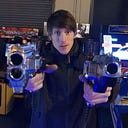Game Retrospective: Guardian Heroes
On the 26th January 1996, Guardian Heroes was first released for the Sega Saturn in North America. The game would launch in Japan the day after with a European release following 5 months later.
Guardian Heroes was developed by Tokyo-based studio, Treasure, a studio who had previously worked on a slew of Sega Mega Drive hits, including Gunstar Heroes, Dynamite Headdy and Alien Soldier. It would be their first title developed for the Sega Saturn. Tetsuhiko “HAN” Kikuchi, who had previously created many of the character designs for Gunstar Heroes, took on the role of designer and project lead, while Masaki Ukyo served as director.
In Guardian Heroes the player is prompted to select one of four initial adventurers (Han, Nicole, Ginjirou or Randy), who at the beginning of the game, discover an ancient sword. The heroes soon discover that the king’s adviser, Kanon, also seeks this particular sword and has dispatched the royal army to retrieve it. During a showdown with Valgar, the leader of the Black Knights, the heroes discover that the sword can be used to summon the undead form of its original owner, the Golden Warrior; a powerful entity which the heroes decide to harness in their quest to defeat Kanon. From this point on, the game splits into several branching paths that can each lead to multiple different endings. While the game is a side-scrolling beat ’em up, in essence, it is notable for also including several RPG elements, such as experience points.
The idea for Guardian Heroes first began to form after Kikuchi expressed a desire to create a game where the player could fight a large number of enemies all at once. Although he understood the need to be cautious when adopting such an approach, and avoid overbearing the player with on-screen content, Kikuchi believed that vanquishing wave after wave of enemies would be immensely satisfying and pushed ahead with the premise.
One game that influenced Guardian Heroes development was the 1994 arcade title, Aliens vs. Predator, developed by Capcom. Kikuchi was impressed by the game’s fast and frantic gameplay, in addition to the power and control it offered the player. In a 1996 interview featured in the Japanese magazine Game Hihyou, Kikuchi stated: “When I saw [Aliens vs, Predator] the first time, I was like, “Yeah! This is what I’ve been looking for!”
Composer Natsuhiro (Nazo²) Suzuki, who had previously worked on the Treasure titles, Dynamite Headdy and McDonald’s Treasure Land Adventure, composed Guardian Heroes’ soundtrack, along with Hideki Matsutaka, a musician often referred to as the fourth member of the Japanese electronic band, Yellow Magic Orchestra. As Guardian Heroes was Treasure’s first CD-ROM game, the soundtrack was not limited by the sound hardware of the cartridge-based Mega Drive. This allowed the composers the freedom to create a soundtrack that, albeit electronic in nature, incorporated a wide selection of sounds including electronic guitars and saxophones.
Upon release, Guardian Heroes received praise for its challenging gameplay, branching paths, available combos and replay value. While the game’s presentation has retrospectively received much praise, the games 2D character sprites were criticised by some reviewers at the time, who believed them to be out of place on the, then, next-generation Saturn console. The game has grown to be a fondly remembered title, regularly scoring highly on many retrospective polls.
The game would receive an HD remaster in 2011 released for Xbox Live Arcade. This version of the game featured a remade UI, widescreen support, bilinear filtering and the option to select both new and original graphics modes. During the development of the remaster, Treasure discovered that the source code for the game was stored on DAT cassettes, for which the company had to borrow equipment from Sega to access. A sequel, Advance Guardian Heros, would be released in 2004 for the Game Boy Advance.
🕹Are you a fan of Guardian Heroes? Did you enjoy the Xbox Live Arcade remaster? Which other Treasure games have you enjoyed? Which are your favourite side-scrolling beat ’em ups?🕹
